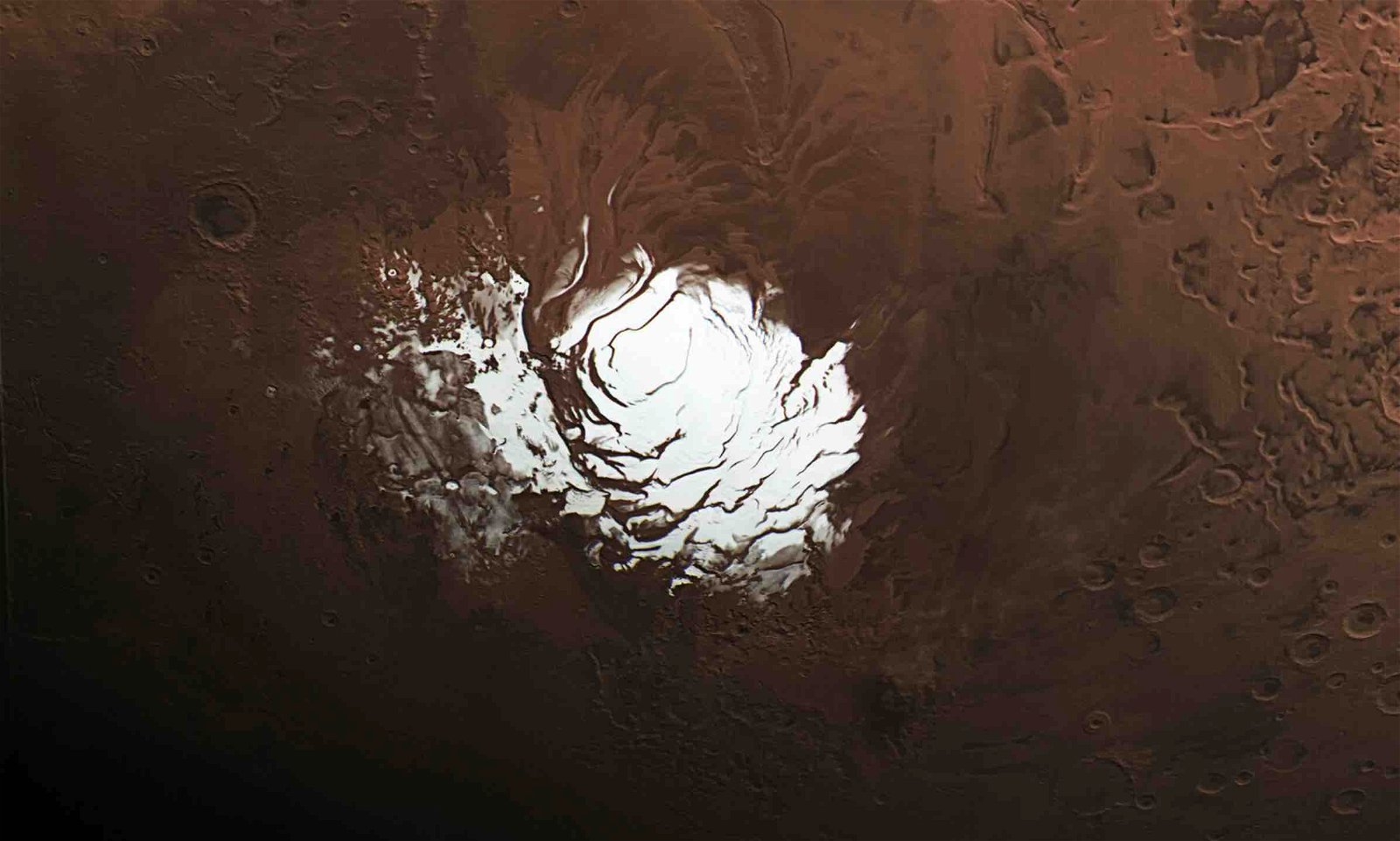Newly published research from scientists at Cornell University is casting doubt on previous findings hinting at the presence of a large lake of liquid water underneath Mars’ polar ice caps. Instead, the researchers say their models were able to produce the same signals detected by the Mars Reconnaissance Orbiter back in 2018 in a simpler and likelier way that doesn’t require the presence of liquid water.
Previous studies have found overwhelming evidence for large amounts of water billions of years in Mars’ past, increasing the possibility that life may have had a chance to evolve on the red planet. However, the presence of liquid lakes on or underneath Mars would greatly increase the chances that life currently resides on the red planet. If confirmed, these latest findings, which say the readings were caused by ice reflections, would represent a dramatic setback to those hopes, potentially restricting any living Martian organisms to the planet’s watery ancient past.
“I can’t say it’s impossible that there’s liquid water down there,” said Daniel Lalich, research associate at the Cornell Center for Astrophysics and Planetary Science and an author on the study outlining the team’s findings, “but we’re showing that there are much simpler ways to get the same observation without having to stretch that far, using mechanisms and materials that we already know exist there.”
In fact, Lalich is so confident in his team’s findings that he says random chance could “create the same observed signal in the radar.”
Evidence for Liquid Water Underneath Mars’ Polar Ice Caps
Ever since NASA and the European Space Agency began sending various probes, rovers, and satellites to Mars, they have found a steadily increasing body of evidence that the red planet was once home to large amounts of liquid water. Some research even showed that a massive ocean may have existed on Mars’ surface around three billion years ago, even though the temperature at the surface was well below freezing, thanks to constant water circulation and periodic coastal rainfall. An examination of rocks collected by the Perseverance Rover also found that water in Jezero Crater may have persisted for much longer than previously thought, increasing the opportunity for life to form.
Later, other research seemed to cast doubt on the amount of water on ancient Mars, instead ascribing much of the evidence to CO2 ice flows. While recent experiments continue to hint that the planet was once very, very wet, most researchers agreed that Mars had no current liquid water.
Then suddenly, in 2018, researchers using the ESA’s Mars Express spacecraft reported the discovery of a large lake of liquid water underneath Mar’s polar ice caps in the Planum Australe region. The researchers were so confident in their findings that they went so far as to say that the 20km wide lake “is probably kept from freezing by dissolved salts and the pressure of the ice above.”
Those findings found further support when, in 2021, University of Cambridge researchers using data captured by the Mars Global Surveyor’s altimeter provided new evidence supporting the presence of a large lake of liquid water beneath Mars’ polar ice caps.
Now, both of those studies have been called into question, with the new models suggesting that the reflections that seemed to indicate the presence of this massive lake were likely just illusions created by layers of ice.
Randomly Generated Layering Scenarios Replicate Readings Without Need for Water
In the media release announcing the new findings, Lalich notes that he had developed earlier models that could account for the presence of reflections underneath the Martian ice caps. However, he says that those models, which relied on assumptions about layers of frozen carbon dioxide hiding beneath the ice caps, “likely were incorrect.”
Hoping to refine his approach, Lalich says he decided to use much more sophisticated modeling techniques, which helped in “closing the gaps” in his radar interference hypothesis. This included modeling thousands of randomly generated layering scenarios based specifically on the atmospheric and material conditions present only at the Martian poles. Throughout these different scenarios, Lalich and his team periodically adjusted the spacing and composition of the various ice layers, like those already known to exist beneath the surface of Mars, while monitoring how this would affect readings captured by a satellite like the Mars Express.
Just like his previous models, Lalich said that those slight adjustments started to produce “bright subsurface signals consistent with observations” found by all of the three frequencies analyzed by the Mars Express orbiter’s MARSIS radar instrument during the 2018 discovery. In effect, his data showed that when the RADAR waves bounced off of ice layers that were too close together for the MARSIS instrument to tell them apart, the instrument most likely combined them together, resulting in amplified peaks and troughs in the signal that matched those made by liquid water.
“This is the first time we have a hypothesis that explains the entire population of observations below the ice cap without having to introduce anything unique or odd,” Lalich said. “This result where we get bright reflections scattered all over the place is exactly what you would expect from thin-layer interference in the radar.”
While this research doesn’t permanently shut the door on the idea of liquid water underneath Mars’ polar ice caps, the researchers behind the finding do seem to agree that the scientific community tends to prefer the simplest explanation whenever possible, as opposed to the one that is more exciting.
“The idea that there would be liquid water even somewhat near the surface would have been really exciting,” Lalich said. “I just don’t think it’s there.”
Christopher Plain is a Science Fiction and Fantasy novelist and Head Science Writer at The Debrief. Follow and connect with him on X, learn about his books at plainfiction.com, or email him directly at christopher@thedebrief.org.

